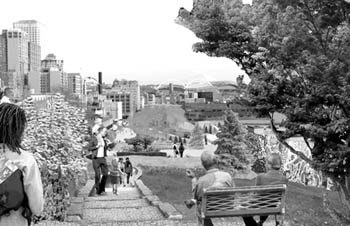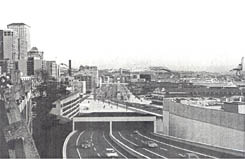|
||||
|
|
|
|||
| Home | Subscribe | Back Issues | The Organization | Volunteer | ||||
|
||||
|
Viaduct SolutionLet's just get rid of it!by Nate Cole-Daum and Cary MoonThe 53-year-old Viaduct, a two-mile stretch of State Road 99, is soon to be removed from the heart of Seattle's landscape. But the state Department of Transportation insists that a new highway will be built in this exact location, and plans have been floated to do just that. They're aiming to build what they call the "tunnel", which is actually part surface highway, part lidded trench, and part aerial highway. One problem is that building any new highway is going to cost Washington state taxpayers several billion dollars, and more--perhaps much more--if there are the cost overruns typical of any similar highway megaproject. If a replacement for the viaduct is built, the Downtown waterfront will be closed to most of its current traffic for at least a few years. In the meantime, the Seattle area will implement a temporary plan to minimize and divert north-south traffic through Downtown. Here's an innovative idea: why not just make that plan permanent? Why not create a city which is simply less dependent on cars, and which enjoys the benefits of being so? In other words, get rid of the old viaduct and don't build a replacement. When the Viaduct was built in 1953, Downtown was strictly 9-5 and the waterfront was a neglected zone of post-industrial blight. The possibility of Downtown as a place to live, or the urban waterfront as prime civic real estate, was unimaginable. So that's where they put the highway. Well, maybe it made sense then, but how on earth does it make sense now?
The People's Waterfront Coalition has a different vision for this land: a dynamic water's edge with parks, beaches, recreation paths, event spaces, and an urban street integrated into shore ecology. But where will all those cars go, and what about the people who use the Viaduct? Our alternative transportation solution was developed by transportation and planning experts steeped in the commuting and political challenges particular to Seattle. To embrace this once-in-a-lifetime opportunity to enhance livability throughout the city, we propose a plan that is at the same time more comprehensive and more doable than building a new highway. The key components are: 1) Maximizing under-used arterial streets by knitting together missing links and untangling bottlenecks (the fabric of our street network has become scrambled and disjointed in service to funneling cars on and off highways). 2) Improving flow on I-5 by moving the ramps to the proper side of the freeway and reconfiguring the express lanes. 3) Timing stoplights to keep more of the traffic in motion. 4) Adding transit and linking the different modes to motivate more people to use it. 5) Dedicating freight priority lanes. 6) Building a new 4-lane urban street in Alaskan Way's place. If you think a well managed city would have tackled housekeeping items like these long ago, you're not alone. A deeper look finds these common sense and overdue improvements have been delayed by the undue attention received by megaproject proposals, which make the nightly news--and make for exciting reelection campaigns--whether they make sense or not. To think smart, you have to think small. Seattle leaders want to create a future with more vibrant neighborhoods, better livability Downtown, and less car-dependence. To get there entails offering great transit, creating great streets with desired destinations within walking distance of home, and building enough in-fill development. Spending a minimum of $4 billion of scarce public money on a very short stretch of new highway not only sucks up money that could be more wisely invested in smaller and more modest projects, it actually perpetuates one of the roots of urban congestion: back-ups where the highway meets the grid. To get a clear view, let's back up and look at the big picture. How does Seattle move? * Cars--This is probably the first mode of transportation that comes to anyone's mind. While it remains an integral fact of city life, in a well-designed (and well equipped) city, the private automobile gets used less and less as civic amenities increase in your local neighborhood. * Commercial Trucks--After crossing the country with their goods, trucks battle cross-town traffic, delivering all the essentials of city life, from newspapers to beer. That's why our proposal includes prioritizing freight lanes--not just on high capacity roads like I-5, but other arterials that trucks need for access to the retail and distribution centers scattered among urban villages all over the city. * Busses and other mass transit--Now we are getting somewhere, because the heart of the matter is really about moving people, not vehicles. By improving service and adding the links between busses, ferries, streetcars and light rail (present and future) we'd make mass transit a viable option for more and more trips. * Bikes--Seattle is home to one of the staunchest biking populations, with great facilities for recreational cycling and suburbs famous for their biking fever. But ironically, urban facilities are few and far between, and confounded by a plentitude of challenges like high-speed shoulder-less arterials. Cycle commuting remains a thankless sacrifice for most. Re-creating the waterfront, already a key bike route, with enhanced paths and increased public space would be a step in the right direction for Seattle's long-suffering cyclists. * Pedestrians--Perhaps the most overlooked user group in the waterfront's current configuration, these intrepid tourists, urban explorers and Downtown dwellers using the "ankle-express" would be embraced by a shore more serene and tranquil in some places and much more lively in others. Our proposal would reward walkers with eye-level delights like new tide pools, healthy beaches, outdoor cafes, plazas and play spaces--the very essential qualities our urban waterfront is lacking today. Seattle's Mayor was bold when he chose to lead--in spite of our nation's leadership--his group of Kyoto-committed Mayors. In much the same way, we need to commit to a vision of a more sustainable and affordable mobility system for future Seattle. Now is not a good time to repeat a car-centered decision from 1953. We can keep Seattle moving without a roaring, dirty, elevated highway cutting Pike Place Market off from the Waterfront, and without six lanes of fury blocking Pioneer Square from the Piers. To find a good example to follow, we don't have to look far. Seattle citizens blocked several new highways in the 1970s--not only to save their neighborhoods, but also to slow down the sprawl and congestion. The benefits of removing waterfront highways are well-documented: other cities that have removed highways and reduced capacity have seen surprisingly positive results to both mobility and economic vitality. Typically, though, highway planners said it wouldn't work, and pointed to their gridlock-predicting computer models. But each time they were wrong. In fact, in a 1998 study of 60 actual cases of highway capacity reduction in various cities, researchers found that not one experienced long-term traffic chaos or gridlock, despite dire warnings from highway planners. The study found, on average, a 25%--and up to 60%--reduction in the number of trips when the road was removed. San Francisco did it (twice), New York did it, Portland did it, Milwaukee even did it. With advance notice and identified alternative choices and routes, people find other ways to get around. In the real world, people prove to be a lot more flexible than computer models assume. While officials are still pursuing plans to build a new highway, the good news is they are already proposing fixes to roads and transit so Seattle can get by without the Viaduct during demolition and construction. After living without any highway for 3-5 years, it begs the question: will we have already adjusted to life without it by the time construction is complete? Regional and city transportation planners with years of experience and specific knowledge about Seattle helped prepare--and believe in--our alternative solution because it is simple and affordable. Why didn't ideas this practical come from the folks in charge? The only study they performed was what kind of highway they were going to put on our waterfront. With a once in a lifetime opportunity in front of us, we deserved more complete homework. Who knows, looking into the feasibility of this proposal now could take even less time than drumming up a couple more billion dollars for the potential boondoggle of constructing a lidded trench near a fault zone, in liquefiable soil, along the edge of the shore. Check out our math: * Step one, remove the rickety Viaduct. * Step two, heal our city's neglected arterial blockages and add more transit. * Step three, monitor how well people and freight are able to get where they're going, and improve the grid and transit as necessary. That's about it. If you were hoping our proposal would be big and splashy, sorry. But here's what we think: it is smart, it is simple, it is Seattle. Supercomputers? Think microcomputers. Arena-rock? Think garage-rock. Sears Tower? Think Space Needle. Whatever the competition, we here in Seattle think best when we think small. It's how we make hay, and it is what has made us famous. That is why the fantastically flawed and outrageously over-budget Big Dig is not a good fit for Seattle. But, if there is a contest for the cleverest, Seattle is camped out at the audition. You can spot us easily--we're at the front of the line with wool fingerless gloves brewing organic coffee on a pocket stove. That's not to say we don't dream big-city dreams: our path to fulfillment is just the road less traveled.* |
|


